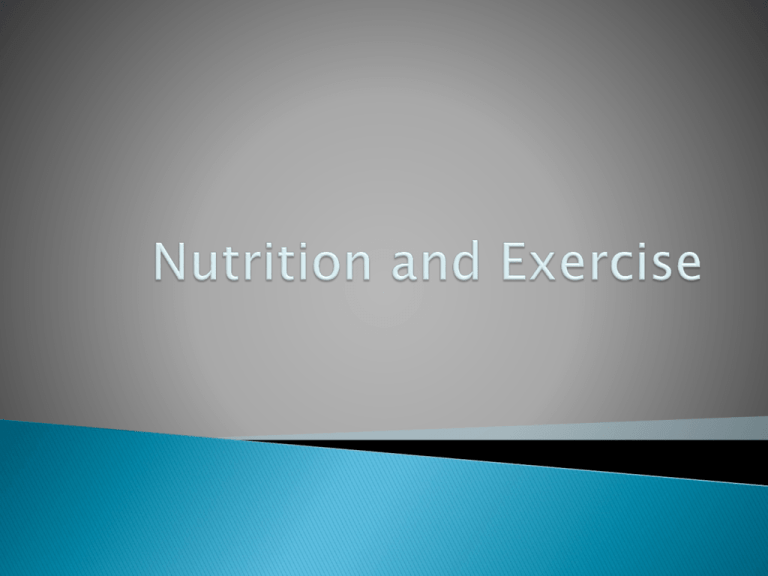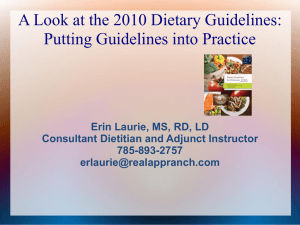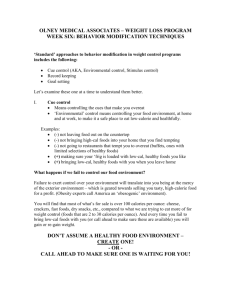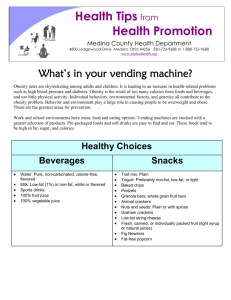Random Math Topics
advertisement

Nutrition is the study of foods, their nutrients and other chemical constituents, and the effects of food constituents on health. Food is a basic need of humans. Foods provide energy (calories), nutrients, and other substances needed for growth and health. Health problems related to nutrition originate within cells. Poor nutrition can result from both inadequate and excessive levels of nutrient intake. Humans have adaptive mechanisms for dealing with fluctuations in nutrient intake. Malnutrition can result from poor diets and disease states, genetic factors, or a combination of these causes. Some groups of people are at higher risk of becoming inadequately nourished than others. Poor nutrition can influence the development of certain chronic diseases. Adequacy, variety, and balance are key characteristics of a healthy diet. There are no “good” or “bad” foods. Heart Disease – high animal (saturated) fat and cholesterol intakes; low intakes of certain vitamins and minerals and vegetables and fruits; excessive body fat. Cancer – Low vegetable, fruit, and fiber intakes; excessive body fat and alcohol intake. Diabetes (primarily in adults) – Excessive body fat; low vegetable and fruit intake; high saturated fat intake. Cirrhosis of the liver – Excessive alcohol consumption; poor overall diets. Hypertension (high blood pressure) – High sodium (salt) and alcohol intake; excessive levels of body fat. Iron-deficiency anemia – Low iron intake. Tooth decay and gum disease – Excessive and frequent sugar consumption; inadequate flouride intake. Osteoporosis – Inadequate intakes of calcium and vitamin D. Obesity – Excessive calorie intake and highfat diets. Aim for fitness… ◦ Aim for a healthy weight. ◦ Be physically active each day. Build a healthy base… ◦ Let the Pyramid guide your food choices. ◦ Choose a variety of grains daily, especially whole grains. ◦ Choose a variety of fruits and vegetables daily. ◦ Keep food safe to eat. Choose sensibly… ◦ Choose a diet that is low in saturated fat and cholesterol and moderate in total fat. ◦ Choose beverages and foods to moderate your intake of sugars. ◦ Choose and prepare foods with less salt. ◦ If you drink alcoholic beverages, do so in moderation. Nutrition labels are required on all foods and dietary supplements sold in the United States. Nutrition labeling rules allow health claims to be made on the packages of certain food products. Nutrition labels contain all of the information people need to make healthy decisions about what to eat. “Free” does not mean zero. Foods that are calorie-free or fat-free on their ads may have a limited amount of calories per serving. “Lite” or “Light” must contain 1/3 the calories or ½ the fat per serving of the original version or a similar product. “Reduced” must contain at least 25% less per serving than the reference food. Everyday Health with Jillian Michaels Understanding Nutrition Labels Gram for gram, carbohydrates provide the body with more energy than protein does. A teaspoon of butter has a higher caloric value than a teaspoon of margarine. Energy can be neither created nor destroyed. It can, however, change from one form to another. A calorie is a unit of measure used to express the amount of energy produced by foods in the form of heat. Basal metabolism Physical activity Dietary thermogenesis This makes up the bulk of most people’s need for calories – usually 60 to 80%. A quick estimate is as follows: ◦ For men: Multiply body weight in pounds by 11. ◦ For women: Multiply body weight in pounds by 10. This accounts for the second highest amount of calories we expend. Three basic lifestyles: ◦ “inactive” about 30% of basal metabolism ◦ “average” about 50% of basal metabolism ◦ “active” about 75% of basal metabolism Calories expended for dietary thermogenesis are estimated at 10% of the sum of basal metabolic and usual physical activity. Determine the number of calories that you need each day. If you are maintaining your weight, the number of calories you need is the number you generally consume. This is a state of energy balance. Energy balance can be effected by ◦ Smoking ◦ Lean muscle mass ◦ Genetic makeup Underweight, normal weight, and overweight are generally defined based on weight-forheight. Obesity is primarily based on body fat content. For women: begin with 5 feet equals 100 pounds, and then add 5 pounds for each additional inch of height. The standard weight is plus or minus 10% of this amount. For men: Begin with 5 fee equals 106 pounds, and then add 6 pounds for each additional inch of height. The standard weight is plus or minus 10% of this amount. Formula: weight (lb) / [height (in)]2 x 703 Calculate BMI by dividing weight in pounds (lbs) by height in inches (in) squared and multiplying by a conversion factor of 703. This is the same for men or women. Everybody needs some body fat. 3 to 5% for men 10 to 12% for women Locate your waist: the smallest circumference below the last rib of the rib cage and above the navel. Locate your hips: measured across the largest circumference of the buttocks. Measure your waist and hips. Divide your waist circumference by your hip circumference. For women: less than 0.80 For men: less than 0.95 Theoretically, about 3500 calories is equal to one pound of weight. To lose one pound per week, you need to consume 3500 calories less that week than you use. You can break this into a calorie deficit of 500 calories per day that you burn more than you consume. As we eat less, our bodies expend calories at a slightly lower rate. This is known a survival instinct that is ingrained in our bodies. They fear starvation. Ask Jillian Calories In vs. Calories Out When you are trying to lose, or even gain, weight you should never dramatically adjust your calorie intake. Always make changes by 10%. Diet and exercise CAN work by itself. You do not need supplements, diet plan foods shipped to you, or a group of people to tell you what to do after you pay them money. It is not true that you can achieve any body weight or shape you desire if you work hard enough. Half the women in the U.S. wear size 14 to 26, yet many clothing models and actresses are severely underweight. The best way to prevent obesity is to become more accepting of people of different sizes and shapes. Healthy is not in a clothes size or even a weight.







